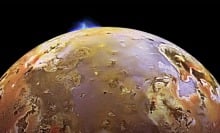NASA's about to launch a huge spacecraft to a world harboring voluminous seas.
Planetary scientists suspect Jupiter's moon Europa contains an ocean at least twice the size of Earth's. The Europa Clipper probe — which is the length of a basketball court and the largest craft the agency has sent on a planetary mission — is slated to blast to this distant realm on Oct. 10. Before the launch, NASA released a new detailed view of the moon's cracked surface, which shows why for decades researchers have been drawn to this tantalizing place.
"It's perhaps one of the best places beyond Earth to look for life in our solar system," Cynthia Phillips, a NASA planetary geologist and project staff scientist for the space agency's Europa Clipper mission, told Mashable.
On Oct. 2, NASA shared the view below, which was taken from data gathered by the Galileo mission in 1998. It shows a close-up of Europa's chaotic landscape, which is evidence that something below the moon's thick icy crust — like an ocean — is stoking lots of change and deformity. Salty water may escape to the surface along fractures, leaving telltale reddish colors on Europa's ground. And irregular chunks of ice have likely been created by relatively recent surface movement.
"This region sports ice rafts that look like those at Earth's poles, where large chunks of ice break away and float freely on the ocean," the agency wrote. "Much of the region bears the reddish/brownish discoloration seen here — the same as seen along many of Europa's fractures. Scientists believe this material may contain clues about the composition of an ocean beneath the icy surface, if it is proven to exist."


To prove whether an ocean exists and if it could host suitable conditions for life, Europa Clipper will make around 50 close flybys of the moon's surface. It's fitted with a number of high-resolution cameras, a ground-penetrating radar, and even a device (called SUDA) that will literally sample particles of Europa that have been ejected into space by tiny meteorites.
After looping through the solar system on a 1.8-billion-mile (2.9-billion-kilometer) journey, the craft will arrive at Europa in 2030, and spend 3.5 years collecting unprecedented data. To determine if the Jupiter moon is habitable, mission scientists need to answer some major questions. For example, all life needs energy: Does this ocean world provide an energy source? And does it harbor the basic chemical ingredients, like carbon, to form the building blocks of life as we know it?
Tweet may have been deleted
And, if all those conditions are satisfied, is there evidence the ocean has been around for billions of years, providing a stable environment for life to evolve and sustain itself in Europa's dark sea?
We'll find out.
Topics NASA

















